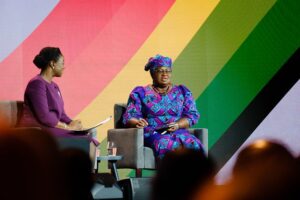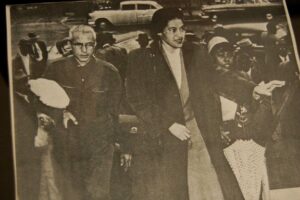 New research published by McKinsey & Company reports on five benefits of paternity leave for families and employers and three ways to make paternity leave more attractive. For this study 130 new fathers and their partners were interviewed in depth across ten countries. The authors note that while heterosexual fathers were the focus of this study, many other kinds of families can benefit from parental leave. The findings of this research extend equally to all.
New research published by McKinsey & Company reports on five benefits of paternity leave for families and employers and three ways to make paternity leave more attractive. For this study 130 new fathers and their partners were interviewed in depth across ten countries. The authors note that while heterosexual fathers were the focus of this study, many other kinds of families can benefit from parental leave. The findings of this research extend equally to all.
Paternity leave is becoming more available as more countries and companies offer the benefit to new fathers. The study notes that
- Worldwide 90 out of 187 countries offer statutory paid paternity leave.
- Four in ten organizations provide paid leave above the statutory minimums.
- Yet less than half of new fathers take advantage of all the leave benefits offered to them because of concerns about damaging their careers.
- Parental leave is also available from some companies for “parental bonding leave” or “secondary caregiver leave” for LGBTQ+ and adoptive parents, but the number of people utilizing these benefits is also small.
The results of this research show five benefits of paternity or parental leave for families and companies:
- Strengthened partnerships—The authors report that 90 percent of men interviewed noticed an improvement in their relationship with their partner. Partners reported positive impacts on their relationship that were less about dividing household tasks and more about their partner’s presence to provide emotional support and share childcare during the early days of baby care. The authors note that other research concurs that paternity leave is associated with greater relationship stability and reduced incidents of maternal postpartum depression.
- Shaped family dynamics—Research shows that early involvement by fathers in parenting through utilization of paternity leave set the foundation for more equal distribution of responsibilities over the years of childrearing.
- Bonding with their child—The study authors note that nearly half of fathers report dissatisfaction with the amount of time they have with their children. In contrast, research indicates that longer periods of paternal leave result in tighter bonds for fathers and children and more frequent engagement by fathers in developmental tasks and caretaking.
- Financial benefits for families—The authors note that paternity leave can level the playing field for working mothers and reduce the gender wage gap. When mothers are able to increase their wages in the short term by remaining in the workforce, the long-term financial well-being of the family increases.
- Increased happiness and fulfillment—This study found that many fathers reported feeling more productive, energized, and motivated to stay with their companies after taking paternity leave.
Despite the benefits of paternity leave, few men take as much leave as is available to them. One study participant explained, “The company was supportive, but the culture was not.” In other words, while the company may have had a policy in place, in practice the work culture looked down on them for taking time off. Encouraging use of paternity leave can increase employee engagement and retention, but nothing will change unless companies
- Provide positive role models of men who take paternity leave
- Ensure that promotions and career timelines are not negatively affected
- Encourage flexible work arrangements for all employees, including men, to allow for fulfillment of family duties
For too long, talk of work-life balance has been focused on women trying to balance career and family life. Both men and women need the support of organizations to be productive and motivated workers in stable families.
Photo courtesy of Jon DeJong (CC BY 2.0)
 The European Space Agency has set a goal of recruiting more diverse astronauts into its training program. Monika Pronczuk, writing for the New York Times, reports that currently only
The European Space Agency has set a goal of recruiting more diverse astronauts into its training program. Monika Pronczuk, writing for the New York Times, reports that currently only  New research from the Eos Foundation’s
New research from the Eos Foundation’s  Ben Casselman of the New York Times writes that a body of evidence has been building for awhile that shows a
Ben Casselman of the New York Times writes that a body of evidence has been building for awhile that shows a  Being the first woman to do something seems to be happening more frequently now across a wide spectrum of roles and industries. It is important to take this moment to notice and mark them. We know there is no guarantee that opportunities will stay open to women unless we stay vigilant. Here are some recent “firsts” for women.
Being the first woman to do something seems to be happening more frequently now across a wide spectrum of roles and industries. It is important to take this moment to notice and mark them. We know there is no guarantee that opportunities will stay open to women unless we stay vigilant. Here are some recent “firsts” for women. I had the good fortune to spend a week at the
I had the good fortune to spend a week at the  Early in the pandemic I wrote
Early in the pandemic I wrote  A long time ago I worked as a bookkeeper for several small restaurants. As I prepared payroll checks, I often wondered why servers were paid less than the minimum wage—a lot less. The current hourly wage is still very low: $2.13 per hour for restaurant servers. I never heard or read an explanation for this low wage until now. A recent article by Michelle Alexander entitled “
A long time ago I worked as a bookkeeper for several small restaurants. As I prepared payroll checks, I often wondered why servers were paid less than the minimum wage—a lot less. The current hourly wage is still very low: $2.13 per hour for restaurant servers. I never heard or read an explanation for this low wage until now. A recent article by Michelle Alexander entitled “ Several recent important moments in history for women in other countries stand out and seem important to highlight. Here are a few.
Several recent important moments in history for women in other countries stand out and seem important to highlight. Here are a few. Let’s mark this moment. As of this writing, President Joe Biden has officially nominated the
Let’s mark this moment. As of this writing, President Joe Biden has officially nominated the